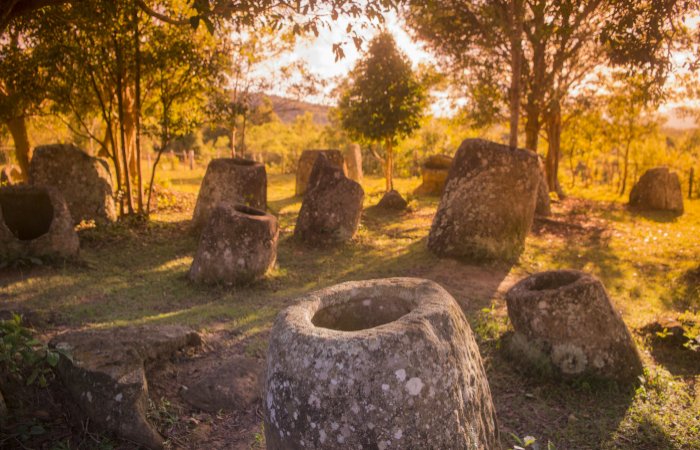Jan Bartek – AncientPages.com – Scientists have tried for years to solve the mystery of Laos megalithic jars. Are they now closer to unraveling the truth behind these giant ancient vessels?
As Ancient Pages reported earlier, “it’s important to mention that similar very large stone jars were found in Sa Huynh in Vietnam and also in the North Cachar Hills of northeastern India, more than 600 miles to the northwest, had roughly the same design and dimensions as the urns in Laos.
Laos jars have long been an archaeological mystery. Credit: flu4022 – Adobe Stock
The jars of Laos are one of archaeology’s enduring mysteries. Experts believe they were related to the disposal of the dead, but nothing is known about the jars’ original purpose and the people who brought them there.”
Mysterious gigantic jars of unknown origin have been discovered worldwide, not only in Laos. Obviously, these huge stone jars must have been important to various different ancient cultures, but why?
A team of scientists from the University of Melbourne has now done a more thorough investigation that may shed new light on this long-standing archaeological mystery, but some questions still remain unanswered.
The Laos Jars Were Of Of Ritual Importance
The megalithic jar sites in Northern Laos comprise one to three-meter-tall carved stone jars, weighing up to 20 tons, dotted across the landscape, appearing alone or in groups of up to several hundred.
Using a technique called Optically Stimulated Luminescence (OSL) to determine when sediment grains were last exposed to sunlight researchers analyzed samples from the Laos jars.
“With these new data and radiocarbon dates obtained for skeletal material and charcoal from other burial contexts, we now know that these sites have maintained enduring ritual significance from the period of their initial jar placement into historic times,” Dr. Louise Shewan from the University of Melbourne said.
Dr. Shewan and her team revisited Site 1 (Ban Hai Hin) that revealed more burials placed around the jars and confirmed earlier observations that the exotic boulders distributed across the site are markers for ceramic burial jars buried below.
Dr. Shewan and collaborators present new radiocarbon results for site use and also introduce geochronological data determining the likely quarry source for one of the largest megalithic sites. Credit: Plain of Jars Archaeological Research Project
In a study published in PLOS One, scientists presented new radiocarbon results for site use and also introduced geochronological data determining the likely quarry source for one of the largest megalithic sites.
While geologists have used detrital zircon U-Pb dating for several decades, this methodology has recently been used to establish the provenance of ceramic and stone sources in archaeological contexts including Stonehenge.
Conducted at ANU by Associate Professor Richard Armstrong, the U-Pb zircon ages measured in jar samples from Site 1 were compared to the potential source material, including a sandstone outcrop and an incomplete jar from a presumed quarry located some 8km away. The zircon age distributions revealed very similar provenance suggesting that this outcrop was the likely source of the material used for the creation of jars at the site.
How The Jars Were Moved From The Quarry To The Site Remains A Mystery
According to Associate Professor O’Reilly, it’s still unknown how the huge jars were transported from the quarry to the site.
Scientists will now obtain further samples from other sites and from across the geographic expanse of this megalithic culture to understand more about these enigmatic sites and the period over which they were created.
See also: More Archaeology News
Dr. Shewan said this is not an especially easy task given the extensive unexploded ordnance (UXO) contamination in the region where less than 10 per cent of the known jar sites have been cleared.
“We expect that this complex process will eventually help us share more insights into what is one of Southeast Asia’s most mysterious archaeological cultures.”
Written by Jan Bartek – MessageToEagle.com – AncientPages.com Staff Writer







